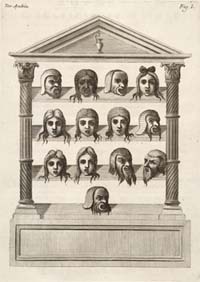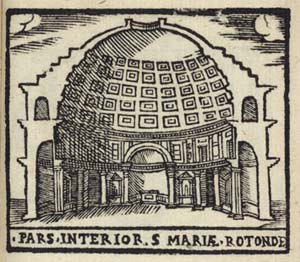|
| Dramatic masks, from a bilingual Latin and Italian
edition of the plays of Terence, published in Rome in 1767 |
The Classical World
From the Renaissance until the end of the nineteenth century, classical
learning underpinned scholarship in the humanities. This intense
study of the philosophical, artistic and archaeological remains
of antiquity is manifested in a vast body of publications reflecting
the hegemonic conception of human civilisation in the post-medieval
West. The Friends have rendered significant assistance to the University
Library in assembling its collection of editions representing this
aspect of academic activity. From early printings of classical literary
and philosophical texts to lavishly-produced descriptions of excavations
of Greek and Roman sites, adorned with plans and engravings, donations
and purchases made through the Friends have served to document the
modern world’s fascination with its intellectual and aesthetic
roots.
Items on display
Girolamo Franzini (fl. sixteenth century), Icones
statuarum antiquarum urbis Romae, Rome, 1599 (F159.e.2.6);
Louis de Montjosieu (fl. sixteenth century), Gallus
Romæ hospes, Rome, 1585 (F158.c.2.14); Publius Terentius
Afer (186 or 5 B.C.-c. 161 B.C.), Comoediae, Rome, 1767
(F176.bb.2.1-2); Josef von Stichaner, Römische Denkmäler
in Baiern, Munich, 1808 (8000.a.24). View
exhibit captions.
|

